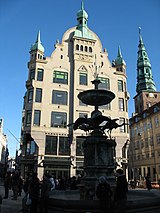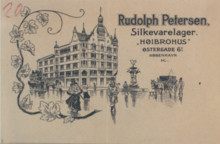
Højbrohus is an Art Nouveau-style building situated on the east side of Amagertorv, between Østergade and Store Kirkestræde, in the Old Town of Copenhagen, Denmark. It houses Café Norden on the two lower floors, and HAY House, a HAY flagship store, on the second floor.
History
17th and 18th century

Store Lækkerbidsken, a hotel, was built at the site in 1656. It developed into the leading place of accommodation in the city.
The large property was listed in Copenhagen's first cadastre of 1689 as No. 31 in the city's East Quarter. It was owned by etatsråd Elias von Hübsch (1793–) at that time. The property was listed as No. 36 in the new cadastre of 1756 and belonged to vice mayor Grøn's widow at that time.
19th century

The building was destroyed in the Copenhagen Fire of 1795. A new building with seven shops in the ground floor was completed at the site shortly thereafter,
The property was listed in the new cadastre of 1806 as No. 37 in the city's East Quarter. It belonged to commandant at Rosenborg Castle Cæsar August Wilster (1734–1812) at that time.
The building would later become known as Peter Egholm's House (Isenkræmmer Peter Egholms Gaard) after one of its owners.
The current building


It was demolished in the mid-1890s to make way for the current building, Højbrohus, which was built in 1896 to design by Richard Bergmann (1860–1925).
Architecture
Højbrohus is built to an Art Nouveau-inspired design with many decorative details. A facade towards Amagertorv has a Dutch gable. The projecting central bay finishes in an onion domed spire, creating a tower-link silhouette against the rest of the building. The central "tower" is flanked by smaller, onion-domed turrets at the corners. The facade towards Amagertorv is also decorated with several reliefs and other ornamental details.
The facades towards Østergade features a smaller Dutch gable as well as many other decorative details.
See also
References
- "Københavnske Jævnførelsesregistre 1689-2008". Selskabet for Københavns Historie (in Danish). Retrieved 2 March 2021.
- "Dengang på Strøget". dengang.dk (in Danish). Retrieved 6 September 2018.
- "Østergade 61". indenforvoldene.dk (in Danish). Retrieved 6 September 2018.
External links
55°40′44″N 12°34′48″E / 55.67889°N 12.57996°E / 55.67889; 12.57996
This article about a Danish building or structure is a stub. You can help Misplaced Pages by expanding it. |